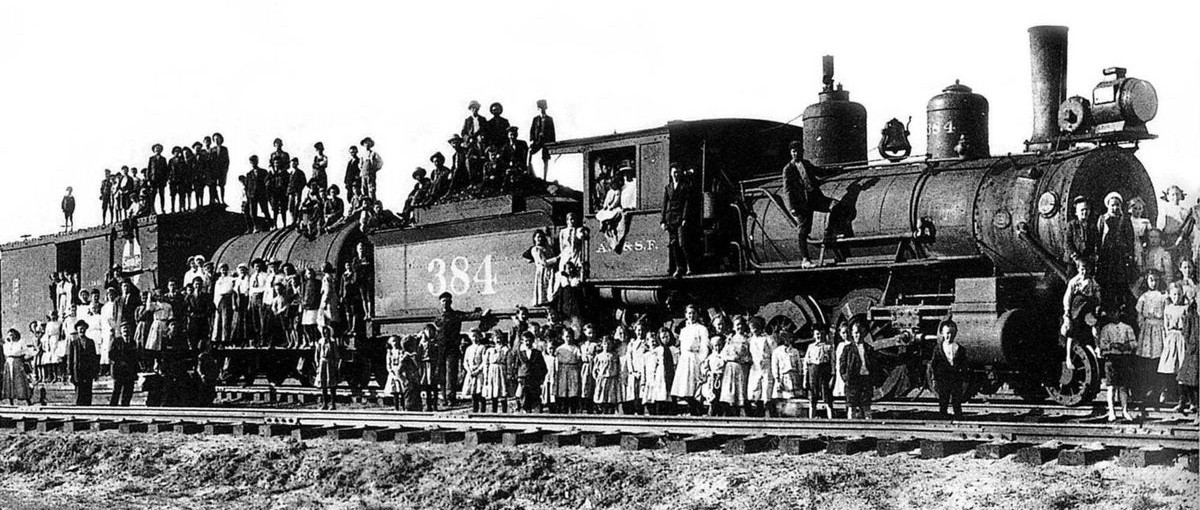
“The Children’s Aid Society of New York,” by Carolee Inskeep
In recent years Americans have come to understand the plight of 19th– and early 20th-century “orphan train riders.” If you’ve read Christina Baker Kline’s best-selling novel, among others, you know that these children were transported by rail from the Eastern United States (especially New York) for adoption/apprenticeship by families in the Midwest. Kline’s novel captures the drama and emotions that these youngsters likely experienced during their travels and aftermaths once they were uprooted and deposited from one existence to another. But, who exactly were these orphans? And how do genealogists discover them and their biological parents?
Author Carolee Inskeep spent years researching precisely these questions when compiling two books on the subject: The Children’s Aid Society of New York and The New York Foundling Hospital. Together these two volumes identify thousands of orphans who lived in two prominent New York domiciles before they were dispersed to Middle America. While this number represents a fraction of the youth touched by the Society’s efforts, Mrs. Inskeep’s books, nonetheless, include all those who stayed in a lodging house long enough to be enumerated in a census, making them the largest published lists of their kind.
Any researchers whose ancestor took part in this crucial migration of children can profit from consulting Carolee Inskeep’s books, and they might just find some clues about the orphan train riders by reading the Introduction to The Children’s Aid Society of New York, which is reprinted in its entirety below:
“In August of 1917, a young mother abandoned her baby daughter on the steps of the Children’s Aid Society at 422 West Twenty-Third Street. She left an unsigned note requesting that, someday, she be allowed to see the child “and kiss her sometimes.” Employees took the baby inside and began to search for the mother. When they failed to find her, the Society contacted the “New York Herald.“ The next day, the newspaper printed a photograph of the little girl clutching her doll, along with a notice assuring the mother that she would be allowed to visit her daughter if she would identify herself. The woman materialized within hours. She explained that she worked as a maid and had no one to look after her daughter while she was away from home. While the case was technically one of child abandonment, the Children’s Aid Society concluded that the woman simply needed day care for her daughter. It arranged to place the baby in a temporary home until the mother could care for her permanently.
The girl with the doll was just one of thousands of children touched by the Children’s Aid Society. Founded to improve the condition of New York City’s neglected youth, the Society offered housing, food, clothing, education, and employment to those who needed it most. It provided day care centers and foster home care for children like the little girl left on the doorstep. Of all its early work, the Society is best known for its “Emigration Plan” which removed 30,000 children from New York City’s streets to private homes in the country between 1854 and 1929. Many of those sent out were recruited from the Society’s lodging houses.
It was estimated that three-fourths to four-fifths of New York’s vagrant children were the sons and daughters of recent immigrants. The neighborhoods in which they lived profoundly affected a young minister named Charles Loring Brace. He once described the immigrant quarters as “the infamous German ‘Rag Pickers Den’ in Pitt and Willett Streets, double rows of houses flaunting with dirty banners, and the yards heaped with bones and refuse, where cholera raged unchecked in its previous invasion; murderous blocks in Cherry and Water Streets, where so many dark crimes were continually committed and where the little girls in old shawls who flitted about with baskets became familiar with vice before they were out of childhood.”
In 1848, New York City’s police chief estimated that nearly 10,000 unsupervised, uneducated, and unemployed children roamed the city streets. That year, the Carmine Street Presbyterian Church, of which Brace was a member, established regular “Boys’ Meetings,” religious services for indigent youths who were reluctant to worship among the affluent. The church made use of songs, pictures, maps, illustrations, anecdotes, and simple instruction in an attempt to elevate the boys’ education and moral character. The meetings were so successful that nine other groups established similar meetings in other parts of the city. They eventually claimed a total average attendance of over 1,000 boys.
Wanting to do more, those most active in the original Boys’ Meetings organized themselves as the Children’s Aid Society in February of 1853. Brace, well traveled and familiar with European social programs, was named Secretary. The group’s listing in the 1854 New York City Directory states that “the objects of this society are to help the class of destitute children of New York by opening Sunday Meetings and Industrial Schools and, gradually, by forming lodging houses and reading rooms for children and by employing paid agents whose sole business shall be to care for them.”
If proposed today, the Society’s most famous program might spark outrage. In his now-infamous essay, “The Best Method of Disposing of Our Pauper and Vagrant Children” (1859), Brace noted the national demand for child labor. He argued that the Children’s Aid Society should:
“connect the supply of juvenile labor of the city with the demand from the country, and place unfortunate, destitute, vagrant, and abandoned children at once in good families in the country. We have no hesitation in saying that all the pauper children, young vagrants, and petty offenders might with ease be placed in good religious homes in our rural districts where every influence exerted upon them would be far healthier and better.”
With this Emigration Plan in mind, the Children’s Aid Society approached farmers across the country and invited them to employ vagrant children. The Society agreed to transport the children to the country; in exchange, farmers agreed to provide the children with good homes and work. The first attempt at placement, in 1854, resulted in 300 offers of employment in Michigan. Two-hundred and seven children were successfully placed in “the country.”
From the beginning, the Society employed “visitors” to comb through poor neighborhoods. They directed children to the Society’s newly formed industrial schools and lodging houses. Others were gathered from local prisons, asylums, and poor houses. Children sometimes presented themselves to the Society in an attempt to escape homelessness, poverty, or abuse. Many of them were referred to the Emigration Department.
Children received by the Emigration Department were questioned about their past history, parentage, and physical condition. If accepted into the program, they were bathed and dressed in new clothes. Groups of them were loaded onto trains and sent to towns across the U. S. The day after a group arrived, farmers and others desiring to take the children assembled. An advisory committee, composed of “responsible citizens” acquainted with the applicants, located the children primarily in the families of farmers. These children were later dubbed “orphan train riders.”
Competing charities organized their own “orphan trains” and “indentured” children to prospective employers. This was a legal arrangement in which the employer agreed to provide for the child “financially and in every other way” as if it were his own. In exchange, the child’s labor and good behavior were guaranteed until age 18.
Proof that the children had actually “turned out well” was hard to come by. The Society had difficulty keeping track of the children once they had been placed in the country. There were accusations that children ran away from their employers or committed crimes. Admitting as much, Brace reasoned that even if one quarter of the children ultimately became a burden to society, the Emigration Plan had not been in vain “for in the city, we can hardly doubt that 95 percent would become in some way burdens to society.”
In its Annual Report of 1900, the Children’s Aid Society noted that of the 22,121 children it had sent to permanent homes in the country, nearly 40% had been recruited from the Society’s lodging houses.
The first and most renowned lodging house was the Newsboys’ Lodging House, opened on the top floor of “The Sun” newspaper building in 1854. Its purpose was to provide temporary housing for the homeless newsboys who worked in Printing-House Square, a plaza bordered by the offices of New York City’s best-known newspapers. These boys were thought to constitute a community by themselves and were regarded as the hardest and most uncontrollable of all the street children in New York.
Beds were rented to the boys for six cents a night, but a condition of admission was that the boy should first take a bath. Supper was available for four cents. A free meal and an hour of religious instruction were provided on Sundays. Books and games were available during the week. Classes were offered in the evening for boys who would otherwise have no opportunity to attend school.
During the first year, 408 boys used the lodging house. C. C. Tracey (Superintendent of the Newsboys’ Lodging House) claimed that these boys were cleaner, better behaved, more industrious, and more religious as a result of the Society’s intervention. This apparent success led to the establishment of at least 20 other lodging houses over the next 70 years. The majority were dedicated to helping homeless boys, but others were set aside for sick children, abandoned babies, homeless women with children, and homeless girls.
Each lodging house contained an industrial school. Children who used the school began the day with a few Scripture verses and ended the day with a hymn. They received traditional schooling in the morning: basic lessons in geography, language, writing, spelling, colors, and music. In the afternoon, the children studied a light trade. The girls learned sewing or housekeeping, while the boys practiced carpentry or box-making. Each child was given a “plain, cheap” dinner and clothed with garments that the girls assisted in making. A paid Matron presided over these schools, while upper-class women volunteered to help the teachers.
The emigration plan, lodging houses, and industrial schools remained until the end of the 1920s. Children’s Aid Society President William Church Osborn was then able to claim: “While there are fewer starving children today than in the past, we still find weary little bodies impoverished through improperly selected and ill-prepared food, neglected teeth and tonsils, insufficient sleep, inadequate housing and lack of activity in the open air and sunshine. The weakening of the home as a factor in the child’s life calls for aid directly supplemental to the home during the nine-tenths of his time which he spends outside his school.” To address these new problems, the Society re-evaluated its work. It closed down the industrial schools, transferred its students to public schools, and converted its old schools into recreational centers. They planned to open a “colored club and health center” in Harlem and a psychiatric clinic for children. They phased out the lodging houses. The Emigration Department became an adoption agency.”





